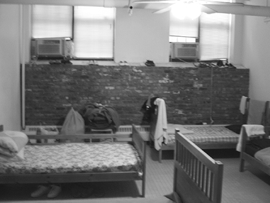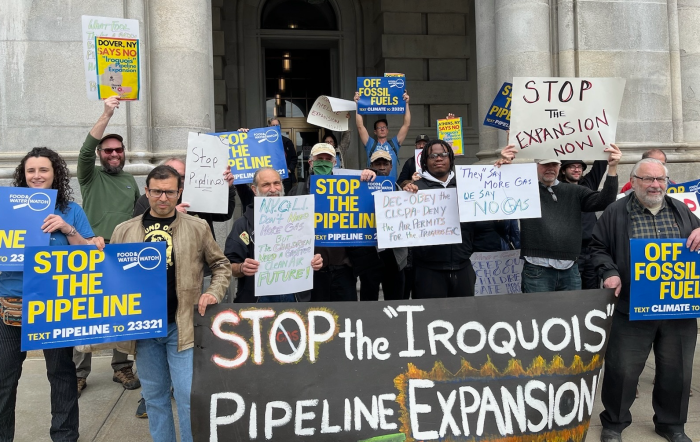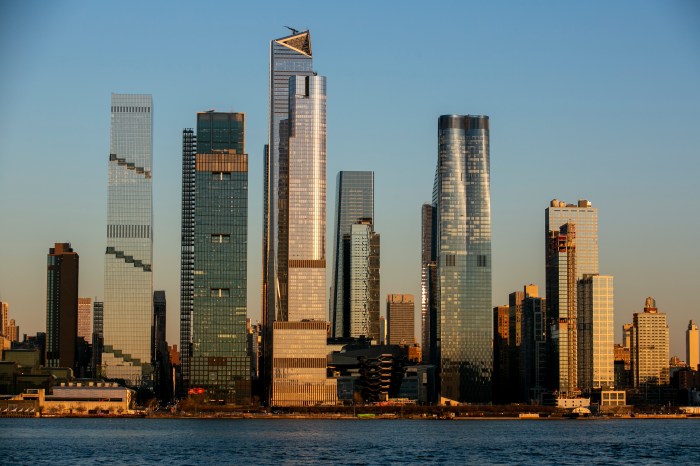Volume 5, Number 39 | Sept. 28 – Oct. 4, 2006
YOUTH
Building A Humane Model
Ali Forney Center attacks queer homelessness with tools aimed at leveraging strengths
New York City, dating back to its days as an early American manufacturing center, has been known for its large population of homeless young people. In the past several decades, it has become clear to experts who have studied the phenomenon of “street-involved” youth, both here and elsewhere around the nation, that a disproportionately high percentage of those in need of shelter are gay, lesbian, bisexual, or transgendered together with those just beginning to question their sexual and gender identity.
Yet it’s only been in the past few years—really, no more than four—that political leaders in the city have begun to focus specifically on homeless LGBTQ youth, and the way in which their special needs and the stigma they face in large institutional shelter settings create problems difficult to tackle.
And it’s only recently, as well, that major gay organizations have turned their gaze—and their financial resources—toward this problem.
Among those responsible for creating this changed climate is Carl Siciliano who, in 2002, founded the Ali Forney Center, a residential opportunity and housing stabilization social service agency targeting LGBTQ youth in need of shelter in order help them find permanent solutions. Ali Forney was a homeless gay youth working as an HIV prevention peer counselor when Siciliano got to know him through his own work. The young man was murdered on the streets in 1997. When Siciliano founded the Center in Forney’s name, he had already worked with homeless young people for a decade, and for several years before that with adults in need of shelter. He decided that the problem of LGBTQ homeless youth needed specialized attention.
In the years since 2002, Siciliano has built an organization that currently houses 28 youths, aged 16 to 24, in four facilities, both emergency and transitional—the latter aimed at preparing residents for life on their own—in Manhattan and Brooklyn. Within six months, that number will grow to 54—30 emergency and 24 transitional—with one new facility already coming online on the Upper East Side. Ali Forney has a $3.2 million budget—$1 million from the federal Department of Housing and Urban Development (distributed, however, out of a New York City planning council), $1.4 million from the federal Housing Opportunities for People With AIDS program, $400,000 from the City Council, and the remainder from individual donors, benefits proceeds, and foundations.
Most important, to Siciliano, is that he is able to maintain a Chelsea Day Center that provides programming, medical attention, psychiatric counseling, employment planning, housing support, and intensive case management to LGBTQ youth well beyond the numbers it is able to house at any one time.
Back in 2002, there was precious little government money targeted for queer youth needing shelter, yet at that time Siciliano was just as disturbed by the lack of interest in the problem in the LGBT adult community.
“Our movement’s message is to come out, but we’re not thinking about what it takes for gay youth to come out,” Siciliano, who was once a Benedictine monk, said in a 2003 interview with Gay City News. “The gay community is ignoring its own. We need a safety net for our kids who face prostitution, murder, and HIV. There needs to be much more done.”
More to be done, indeed. In recent years, experts have pegged the population of homeless youth in New York at between 12,000 and 20,000. In 2003, spokespeople for both the Empire State Coalition of Youth and Family Service and Safe Horizon’s Streetworks program agreed that a good estimate was 15,000.
And, in all probability, as many as 6,000 to 8,000 of those homeless youths classify themselves as LGBTQ. Over a 15-year-period, the question of what percentage of all kids on the street are queer has been examined over and over again—by the U.S. Department of Health and Human Services, by the Seattle Commission on Children and Youth, by the FBI, by the Journal of Pediatrics, and by the National Gay and Lesbian Task Force, among many groups—and the findings have uniformly set that figure at between 20 and 40 percent.
Gaining a decent estimate of how many LGBTQ kids are among the homeless on American urban streets is important because advocates and researchers have also consistently found that this population is among those with the greatest need. A 2002 study by a team from the University of Washington psychology department—thought to be the most comprehensive to date—found that homeless queer youth, compared to their straight peers, were more likely to leave home as the result of physical abuse and alcohol problems at home and once on the streets were at far greater risk of being victimized physically and sexually. A wide array of groups—including the Adolescent AIDS Program at Montefiore Medical Center in the Bronx, the Cézar Chávez Institute at San Francisco State University, and the Child Welfare League of America—have examined institutional responses to the challenge of homeless LGBTQ youth with an aim of improving the standards of care and services.
But on the ground, especially here in New York, the situation remains critical. Covenant House, founded by a Catholic priest more than three decades ago, is the nation’s largest provider of shelter for homeless youth, but advocates and queer youth who have turned to Ali Forney agree that it is at best a problematic solution for LGBTQ kids. One Ali Forney Center client told Gay City News that a gang had taken hold among the youth population there, forcing him to keep to himself. Another said while he was at Covenant House several years ago, he witnessed male residents harassing queer youth and even heard staff members call gay males “faggot.”
The Urban Justice Center agreed that Covenant House has problems “protect[ing] queer-identified youth,” but has worked with Covenant in recent years to improve the climate there. Still, Siciliano said his housing waiting list of roughly 100 is swelled by those with bad experiences at Covenant or unwilling to chance it there in the first place.
Siciliano’s aim at Ali Forney is to replace the institutional, and too often hostile, environment of a Covenant House with a clean, safe, comfortable, and nurturing environment that queer youth many times forfeit because of problems they encounter with their families of origin.
“The kids have been told, ‘You are so worthless and horrible that we are going to cast you aside,’” he explained, mentioning that roughly 40 percent of the youth he sees have suffered serious violence at home. “It is such a trauma, a kind of catastrophe that they were neglected and assaulted during this part of their life. I want them to find a place where they can heal the wounds that they’ve incurred.”
The Center’s three sites in Brooklyn—an emergency apartment and a transitional one in Clinton Hill and an emergency apartment in Park Slope—are recently-rehabbed and spacious, with clean, comfortable furniture and modern appliances including cable television. The three locations vary in layout—with one housing six residents in a three-bedroom duplex, while another puts all six emergency tenants in a dorm-style bedroom downstairs, though a very large one with a vast common living area one flight up. A large backyard in the Park Slope apartment is a locale where all Ali Forney residents gather for summer barbeques.
The emergency placements are targeted to last about six months, while the youths work on a housing plan that could lead to a transitional situation or permanent independent living. About 20 percent of Ali Forney clients have mental health issues that require more intensive intervention but also make them eligible for other supportive housing from the city. Siciliano said that many of the youths he sees drink alcohol and smoke pot, but that substance abuse problems are not among the most serious issues Ali Forney faces. Those with problems must incorporate some kind of treatment or recovery component into their housing plan.
Interestingly, the most serious drug problems Siciliano has come across are with white youths who come to New York from elsewhere and often get caught up in the crystal meth scene before they arrive at Ali Forney. Most of the New York-born youth who show up at the Center are black or Latino and use pot or alcohol more or less recreationally.
The more common pathologies among the youths Siciliano serves are depression, anxiety, and panic attacks, and the Center also sees a large number of kids who are infected with HIV. Among those Ali Forney clients who spoke to Gay City News, a number readily acknowledged experience in street hustling to get by, though most hope that having a regular place to sleep will allow them to focus on finding less risky employment opportunities.
The requirement for those youths living in transitional housing—where a stay might last two years—is that they somehow be connected to the world of work: a full-time job, part-time work, or an internship, perhaps coupled with college courses. Anyone without a high school degree needs to finish or earn a GED.
Despite their past trauma, its psychological aftermath, and any health or skills handicaps they may have, Siciliano believes that the youth Ali Forney serves can best move forward if they are offered hope and opportunity pegged to their strengths.
“As I thought about the shelter efforts targeting these kids, it all felt pathology-based,” he explained. “If someone is mentally ill, there’s housing. If he has a substance abuse problem, there’s housing. If he has HIV, there was housing. The kid who was struggling with a part-time job or working at McDonald’s had no real way, with the real estate market in New York, to get by. I want to support their strengths and encourage their strengths rather than asking, ‘What’s wrong with you?’”
One key upside he said is that most LGBTQ youth living on the streets or shuttling between temporary places to sleep do not identify as “homeless,” and therefore lack the “battered” sense of failure more hardened adults often suffer from.
The success of those youths he’s watched move beyond transitional housing convinces Siciliano that the approach is correct—and much needed.
For someone who began an organization on his own four years ago, with only his ideas and a very good reputation in the field, Siciliano has made significant stirdes. In addition to winning a renewable stream of federal revenues of at least $2.4 million per year, he has joined a group of other advocates and service providers and political leaders in winning City Council approval for funding targeting the needs of LGBT homeless youth. In the most recent fiscal year, the Council made available $1.2 million—one third each to Ali Forney, Sylvia’s Place, an emergency shelter run by Metropolitan Community Church/ NY (MCC), and Green Chimneys, a diversified children’s service agency that houses more than 60 LGBTQ youth in more than a dozen locations in Manhattan, including a boarding house that serves six children 12 to 16 years old.
Siciliano gives credit to the Council for stepping up with funding, citing in particular Youth Services Chair Lew Fidler of Brooklyn, Alan Gerson, who represents Lower Manhattan and is on Fidler’s committee, and Speaker Christine Quinn, an out lesbian.
Going forward, Siciliano would like to increase support for Ali Forney among non-profit foundations, a direction many social service agencies aim to move in given the vagaries of government funding. Still, he does not aim at an ever-growing organization, and said once the growth to 54 beds is completed early next year, he will not add residential capacity for several more years.
“I don’t want to get a whole lot bigger in terms of scope of services,” he said. “These kids need intensive care that they usually can’t get from large institutions. I want Ali Forney to be a model, to become a core response to LGBT youth rejected by their families. I believe we are building a very effective model for a humane response to this problem.”
Indeed, Siciliano’s efforts at modeling a solution are winning high marks within the gay community. Earlier this year, the Center was honored by the Stonewall Democrats of New York City and similar recognition is forthcoming from the Empire State Pride Agenda at its fall dinner next week and at the Gay and Lesbian Anti-Violence Project’s Courage Awards in November.
But Siciliano’s acknowledgement that he wants to show the way rather than pressing forward with unbridled growth underscores the scope of the challenge still facing advocates for queer youth. Ali Forney will provide up to 54 beds, Green Chimneys roughly 60, MCC/NY hosts a handful of homeless youth at Sylvia’s Place in its Midtown basement and last year opened a similar facility, Carmen’s Place, at the Church of Saint Andrew in Astoria. SafeHome, a facility for 20 HIV-positive youths, is run by Safe Space in a Manhattan brownstone, and there are a few other beds available around the city.
MCC/NY is also set to open at 24-hour drop-in space, the Marsha P. Johnson Center, at 127th Street and Adam Clayton Powell Boulevard in Harlem next month, to supplement day programs run by the Greenwich Village Youth Council, Gay Men of African Descent, or GMAD, and Streetworks. The Urban Justice Center works to provide legal services to homeless LGBT youth, and the Anti-Violence Center also provides critical advocacy when they are victims of crime and abuse. The LGBT Community Center’s Youth Enrichment Services provides a wide variety of outreach, education, and mentoring programs, and FIERCE!, the Fabulous Independent Educated Radicals for Community Empowerment, works on the streets to protect LGBT youth from being displaced from the West Village.
Yet, we are talking potentially about thousands of queer kids, often rejected at home when young, many of them living on the streets, some trading sexual favors for a place to sleep, with few job skills at their ready. The progress Siciliano has made is impressive, and others, quickly, need to follow in his wake.
gaycitynews.com



































